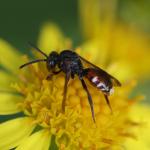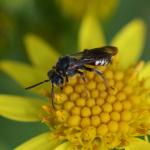Nomada mistura SMITH 1851
A small Nomada immediately distinguished from all other British species by the raised, flat area between the antennal insertions (in other species this area is in the form of a longitudinal carina).
Widely distributed throughout Britain and Ireland, though generally scarce and very local. There are no records of the species from the Channel Islands. A northern and central European species, ranging from southern Finland to France, Germany and the former Yugoslavia.
This species is not regarded as threatened.
Open woodland and grassland, the habitat of its host Andrena.
Univoltine; end of June to late August, occasionally September.
A cleptoparasite of Andrena coitana (Perkins 1919, 1924a, 1924b; Hallett 1928; Chambers 1949) and possibly A. tarsata (Perkins 1919).
Bramble (Rubus fruticosus agg.), creeping thistle (Cirsium arvense), golden-rod (Solidago virgaurea), nipplewort (Lapsana communis), oxeye daisy (Leucanthemum vulgare), ragwort (Senecio jacobaea), sheep’s-bit (Jasione montana), smooth hawk’sbeard (Crepis capillaris) and wild angelica (Angelica sylvestris).
None known.
Profile written:
Updated: 22 December 2011



